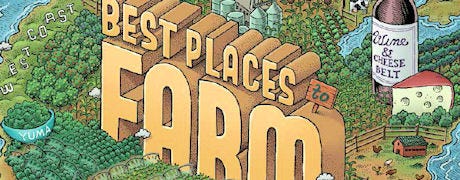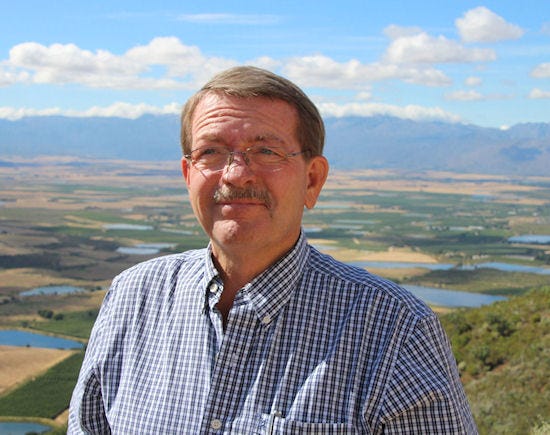
Yuma County, Ariz., is our Best Places to Farm return champion, for good reason. It's a vegetable powerhouse — the nation's winter salad bowl, where farmers grow about 90% of all the leafy vegetables eaten in the U.S. from November through March. You want a high return on assets? Try a year-round growing season, coupled with robust demand, high-value crops and savvy operators.
"With weather being less of a factor, you can focus on the resources and maximize profitability," says John Boelts, general manager at Desert Premium Farms, Yuma, Ariz. "We can sharpen our pencil and calculate things pretty well and hit our targets; it's pretty reliable to target profits even on a small operation."

Weather may be the wildcard for the West Coast but its veggie specialty and year-round growing season aids profits; Pacific Northwest farmers enjoy farm-friendly atmosphere and greater water access
"Yuma is blessed with soils, climate, water and location," says Joe Sigg, Arizona Farm Bureau government relations director. "The farmers who were historically attracted to this area to take advantage of these assets and who navigated through the risks, have taught successive generations how to do it, so success feeds on itself. These are highly successful people who can manage the risks and generate the capital to embrace each technological wave as it comes."
In the arid West, water is always an issue, but not the only worry. Farmers work through the tricky business of growing multiple high-value crops year-round on a schedule timed with demand in other parts of the world. The crops cannot be locked away in a grain bin; a head of lettuce has a four-day harvest window and must be consumed or thrown away within two weeks.
~~~PAGE_BREAK_HERE~~~
"Fresh commodities are high stakes with no insurance, but that volatility provides more profit opportunities," says Boelts.

A concrete delivery system brings water to Arizona farmer John Boelts' fields. High-value crops depend on water rights in the arid Southwest.
Those specialty crops also keep central California counties consistently near the top of our rankings. With its diversity of microclimates and proximity to the Pacific Rim, market demand for California produce is robust.
However, a persistent drought, coupled with tightening environmental regulations, has brought California into crisis mode. According to a recent University of California Center for Watershed Sciences study, the 2014 drought is responsible for the greatest water loss ever seen in California agriculture — about one-third less than normal. The economic analysis of the drought's impact on farming also found $2.2 billion in total statewide costs, including the loss of 17,100 farm-related jobs. At least 5% of irrigated cropland is going out of production in the Central Valley, Central Coast and Southern California. And the drought is likely to continue through 2015, regardless of El Niño conditions.

"In central Washington, agriculture has grown dramatically in the past 10 years, mostly people taking alfalfa and wheat out and putting in permanent crops like grapes and apples," says Alvie Fountain.
"Water is the major threat in the entire state," says California Farm Bureau President Paul Wenger, a third-generation farmer from the Central Valley.
Most of California's people and farms reside in the south, but their water is imported from the north. With the persistent drought, capturing and storing freshwater in reservoirs has become crucial. However, this spring the Natural Resources Defense Council filed a suit against increasing water pumping on behalf of a tiny endangered species, the Delta smelt. As a result, billions of gallons of freshwater were diverted away from California's farm fields and into the Pacific Ocean — all during one of the worst droughts on record.
"They're telling people we don't have enough water to grow crops, but we have plenty to push out smelt," says Wenger. "Any other place, this would be considered criminal.
"The demand will continue to outpace supply for most of our products, but the deciding factor now is not the market; it's the water."
Pacific Northwest: a growing hotbed
Drought politics have forced some California farm operations to flee the Golden State for the Pacific Northwest, an area flourishing due to adequate water rights, hot demand and a friendlier ag environment. The Columbia Basin Irrigated region in central Washington had several counties make our top 200 list of Best Places to Farm.
One farmer who has spent his life there can hardly believe how agriculture has changed. "This area has become a hotbed for ag, and I'm glad I'm in the middle of it," says Alvie Fountain, who owns 3,400 acres in the Columbia Basin irrigated region, on our Best Places to Farm list. "If someone had told me this would be happening to us 25 years ago, I would have said you're nuts. It just keeps ballooning here."
~~~PAGE_BREAK_HERE~~~
A more farming-friendly regulatory atmosphere lured western Washington dairies to the area; cheese and milk processing plants followed suit. Some of the largest onion farms in the country are located here. Permanent crops like apples and winegrapes also flourish.
As long as a farmer has water rights — which the state is no longer giving out — profitability is on the rise.
Like many farmers, Fountain stopped growing corn and is instead signing long-term contracts with companies like Gallo and St. Michelle to install grapes on 600 acres. He plans to convert another 100 acres each year for the foreseeable future, since he has water rights on 2,000 acres.
"I'm converting wheat, pea and corn ground to permanent crops," Fountain says. "That means I'm taking ground that was grossing $1,000 an acre and is now grossing $6,000 to 10,000 an acre."
Winegrapes cost $25,000 per acre and three years to harvest, but the profitability is a lot higher, too, says Fountain. "I could sign contracts for another 5,000 acres right now if I had the land and money to do it."
For farmers who still grow commodity crops like wheat and corn, strong export demand results in a positive basis. "We consistently get higher prices for commodity crops here compared to Chicago prices," says Fountain.
Water remains the key reason for the conversion to permanent crops. Grapes only use 18 inches of water a year compared to corn, which needs 32 inches of water. The region itself only gets about 6 inches of natural rainwater a year, so the right to irrigate factors into every crop decision.
"If I shut down corn acres, I can double my grape production based on 'water spreading,' which means I can take the amount of irrigation water I'm allocated overall and disperse it to various crops as needed," says Fountain. "A lot of people are cutting high-water-volume crops and putting that water on more crops that use less water."
Did you miss a story in our Best Places to Farm series?
Exclusive Study: Best Places to Farm
Do You Live in one of Farm Futures' 'Best Places to Farm'?
Best Places to Farm: Northern Plains and Southeast Boast Energy, Poultry Profitability
Best Places to Farm: Western Corn Belt, Rust Belt Have Easy Access, Agritourism
About the Author(s)
You May Also Like






